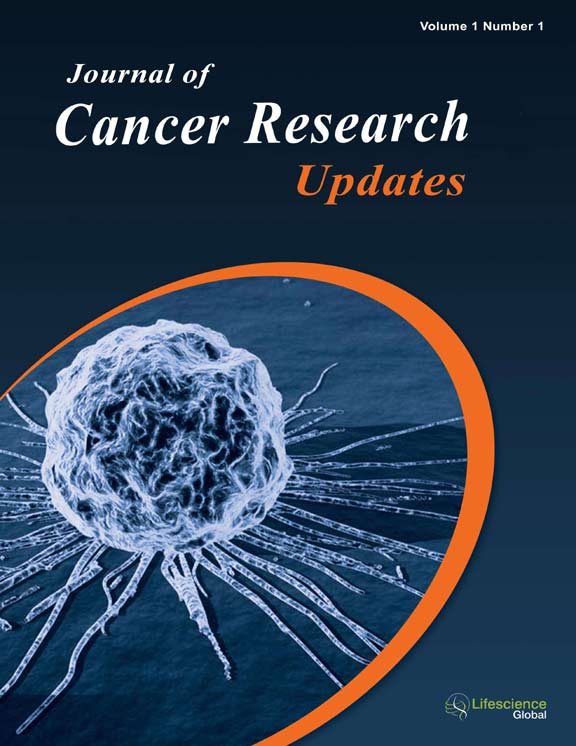jcru
Editor's Choice : Establishment and Characterization of Primary Human Ovarian Cancer Stem Cell Line (CD44+ve)
|
|
Abstract: Ovarian cancer is ranked as the 7th most lethal cancer worldwide with 239,000 new cases annually. The mortality rate is high because most ovarian tumors are diagnosed at advanced stages and are resistant to chemotherapy and thus incurable due to the lack of effective early detection of ovarian tumors. There is a small sub-population of ovarian tumor cells capable of self-renewal and differentiation into different cancer cell types, called cancer stem cells (CSCs), which might be responsible for cancer relapse. The CD44+ phenotype in ovarian tumor cells elucidates cancer initiating cell-like properties of promoting differentiation, metastasis, and chemotherapy-resistance. Increased expression of genes previously associated with CSCs promotes regenerative capacity by promoting stem cell function that can drive cancer relapse and metastasis. In this study we present a method to isolate the primary epithelial ovarian cancer cells from human solid tumor and establish CD44+ve primary ovarian cancer stem cell (OCSCCD44+ve) line using magnetic microbeads. Also we evaluated the expression of stemness genes Nanog, Sox2, Oct4, and Nestin by real-time qPCR analysis. Thequantitative analysis by real-time qPCRshows that OCSCCD44+ve overexpressed the embryonic stem cell marker genes Nanog, Oct4, Sox2, and Nestin when compared with ovarian cancer cells OCCCD44-ve as positive control and ovarian cells as negative control. We demonstrate that CD44 in malignant ovarian tumors is a critical molecule that exhibits cancer stem cell properties that enhance tumorigenicity and cancer metastasis. Our results provide a better understanding of ovarian CSCs, which is important for future in vivo studies with subsequent target therapy for preclinical studies. Keywords: Ovarian cancer, Cancer stem cell, Stemness genes, CD44, Chemo-resistance. Download Full Article |
Editor's Choice : Recent Advances in Understanding the Structure and Function Relationship of Multidrug Resistance-Linked ABC Transporter P-glycoprotein
|
|
Abstract: Mammalian P-glycoproteins (P-gp) are members of the broad family of ABC transporters and play important physiological roles in establishing physical barriers that limit access of toxic compounds and thus in the pharmacokinetics of these compounds. Cancer cells exploit the presence of P-gp to fend off anti-cancer drugs, rendering them multidrug resistant (MDR). Structural investigations of P-gp involve the expression and isolation of this large integral membrane protein in high quality and in sufficient quantity for it to be amenable to electron microscopic (EM) and crystallographic studies. EM studies have defined the shape of the molecule and delineated its various conformations in solution but major breakthrough in obtaining atomic resolution structures of P-gp were accomplished by X-ray crystallography. Structures with increasing resolution and accuracy in various substrate and inhibitor bound forms are available for analysis and novel mechanistic insights have been obtained. These advances have paved the way for future research to further our understanding of the mechanism of P-gp function and development of potential inhibitors that may reverse MDR in cancer treatment. Keywords: P-glycoprotein, ABC transporters, Multidrug Resistance, Mechanisms, Structures. Download Full Article |
Editor's Choice : PET/CT and MRI in Evaluating Cervical Cancer
|
|
Abstract: Positron emission tomography (PET)/computed tomography (CT) and magnetic resonance (MR) imaging are two most important imaging tools for evaluating cervical cancer in clinic. They have improved the accuracy of tumor staging and prognosis predicting in a large part. PET/CT is superior for lymph node (LN) status and metastasis to other imaging modalities. And it could differ among tumor types and grades according to maximum standardized uptake value (SUVmax). MRI is not sensitive to LN metastasis, but it shares the advantage of therapeutic response and recurrence evaluation with PET/CT. Recently, emerging functional imaging modality Diffusion-weighted imaging (DWI) has been showing its superiority on evaluation of cervical carcinoma as well. This article describes both advantages and limitations of MR imaging and PET/CT in evaluating cervical cancer, and reviews the current role of imaging techniques mentioned above. Keywords: Positron emission tomography, magnetic resonance,cervical cancer, staging, treatment response, recurrence. Download Full Article |
Editor's Choice : Concomitant Treatment for Brain Metastases in Non-Small Cell Lung Cancer Patients: Our Clinical Experience
|
|
Abstract: Purpose: Aim of this study was to evaluate tumor response, Quality of life (QoL) and median survival of concomitant chemotherapy (P/E) protocol with WBRT (whole brain radiotherapy) followed by P/E protocol until progression or appearance of serious adverse effects in NSCLC patients with multiple brain metastases. Methods: From December 2012 to April 2014, 12 patients were enrolled in this study. All of the patients received previous treatments. Selected patients had multiple brain metastases detected on CT and/or MRI, and the brain is only one site of disease dissemination and patients were at younger age. External beam radiotherapy was administered with two lateral opposed fields. Concurrently with WBRT, patients received P/E protocol and after 4 weeks, followed by P/E protocol repeated on 21 days until progression or appearance of serious adverse effects. Tumor response was assessed according to RECIST criteria. Assessment of QoL was performed by patients’ subjective answers, subjective improvement in emesis, ataxia, headache and seizures and without subjective improvement. Adverse effects were performed according to WHO criteria. Overall survival was analyzed from the beginning of the concomitant treatment until death or patient’s last control. Results: Common adverse events were neurotoxicity and hematology toxicity according to WHO criteria. No patient was withdrawn from the study because of the adverse events. All patients reported subjective improvements. Overall median survival was 7.5 months (95% CI 6.32-8.73). Conclusions: WBRT plus chemotherapy can improve the efficacy and QoL in NSCLC patients, because of synergistic effect and current evidence that the blood-brain barrier is damaged in patients with BM. Considering our clinical results, we recommend this treatment as safe and effective for selected NSCLC patients. Keywords: Concomitant chemotherapy and WBRT, NSCLC patients, brain metastases. Download Full Article |






















